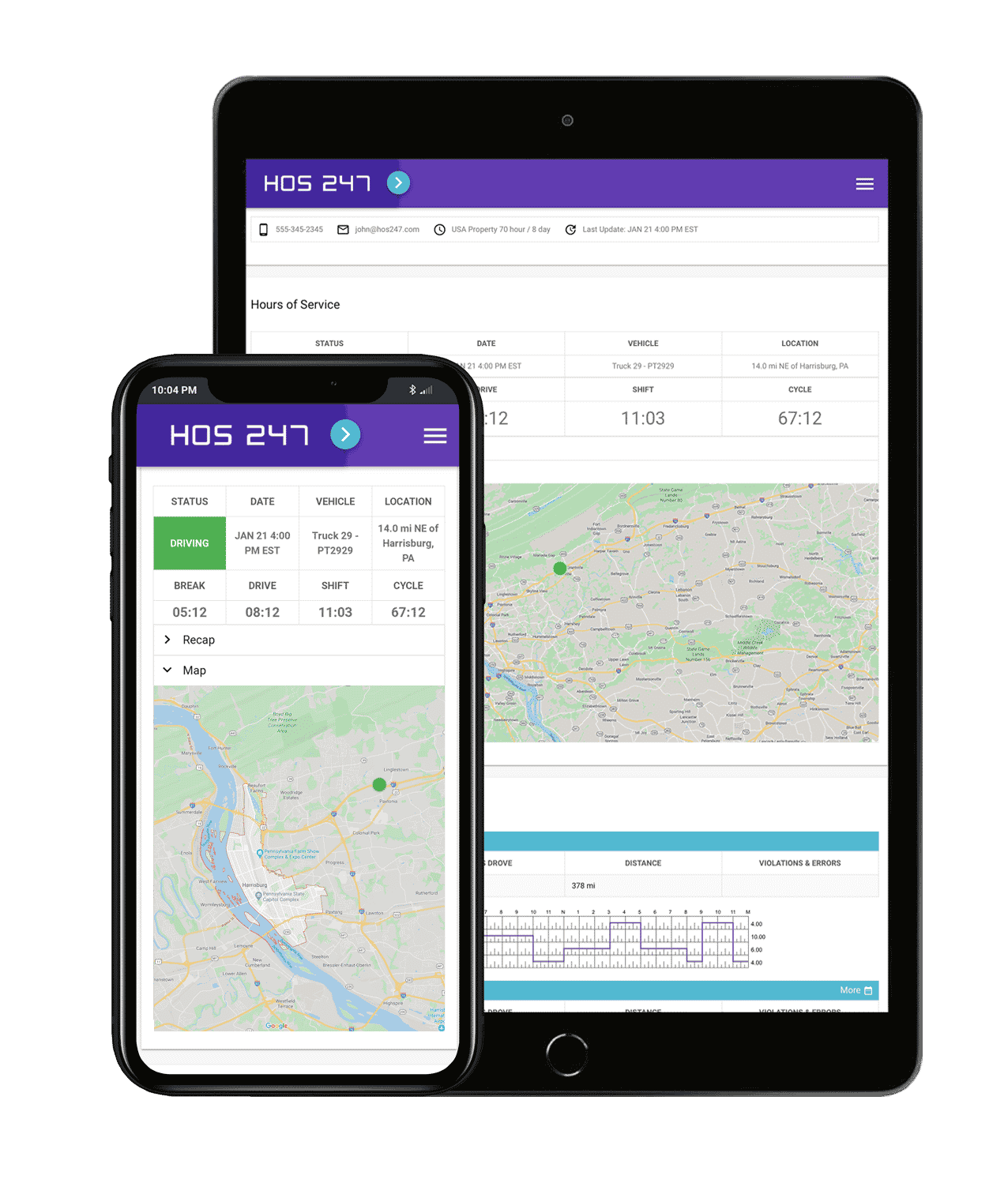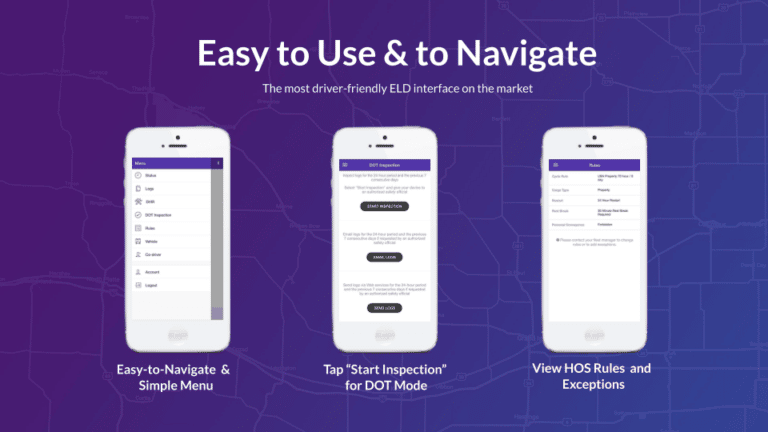The federal mandate for the use of electronic logging devices (ELDs) helps keep drivers compliant with hours of service (HOS) limits. Driver fatigue has proven to cause accidents and losses—human, material, and economic.
The government created HOS rules to deal with this problem, and today ELDs HOS devices are the required way for drivers to maintain accurate records of duty status (RODS). The FMCSA has set guidelines for RODS and monitors drivers and carriers to ensure compliance; those who do not comply with the established rules are subject to hefty fines and penalties.
Do you have any questions? Talk to ELD Advisor: 650-405-3372 or Request Callback
HOS Verification and Enforcement
The FMCSA uses a program for managing safety across the country called the Safety Management System. This system scores carriers based on Compliance, Safety and Accountability (CSA score). CSA scores allow the FMCSA to assess and rank commercial carriers’ level of compliance with road safety regulation. Parts of the score are available to the public and may be viewed by potential clients as well as other trucking companies for comparison.
Observance of HOS rules and proper use of electronic logbooks are an important part of this score. HOS violations are considered as a serious danger, so they have high penalties. Authorities may issue corrective measures such as warnings, investigations, fines and even revocation of carriers’ commercial certification. Keeping ELDs HOS records correctly is in everyone’s best interest.
HOS247 Is a Leading ELD Service Provider
HOS247 has developed a dependable HOS log book to manage RODS and enhance trucking businesses’ performance. We offer customers an HOS pro ELD that combines quality hardware and a user-friendly ELD HOS app to streamline recordkeeping and increase profitability.
Our additional features, customer service, and dedication to being a trustworthy business partner bring additional value to our product. Here are some of the most popular benefits of our elog solution:
- Reliable hardware. Our hardware has been put to the test to make sure that it performs optimally at all times. The HOS247 electronic logbook is tamper-resistant, FMCSA-approved and operates with a stable Bluetooth connection to provide accurate, real-time data collection.
- Compatible ELD HOS app. Our HOS log book app runs smoothly on both Android and iOS smartphones and tablets, adjusting to the driver’s preference and simplifying fleet management.
- Top-rated customer service. We offer top-rated technical support in English, Polish, Russian, and Spanish every day of the week to keep close contact with our clients.
- Trial-period. HOS247 offers a trial period of two weeks so truckers can try out the HOS247 ELD system in real operations. If you are not satisfied, you may return the device within this time and receive a hassle-free refund.
- No-contract policy. Our services can be purchased on a monthly or yearly subscription, there is no need for extended commitments. This way, you can add features or scale your plan up or down according to the specific needs of your business.
- Extra features. To complement our ELDs HOS solutions, we optimize and automate tasks such as IFTA calculations and idle time reports. We also include GPS tracking and vehicle maintenance to prevent breakdowns and extend vehicle life.

What Are DOT HOS Exemptions?
The FMCSA considers certain DOT HOS exemptions that allow drivers to operate outside the rules in some circumstances, including:
- 30-minute break exception. Short-haul drivers working within a 150 air-mile radius from their work station are not required to take a 30-minute break.
- 16-hour short-haul exception. For short-haul drivers, the 14-hour driving window may be extended to 16 hours once every seven days. Property-carrying drivers may use this exception under the following conditions:
-
- They have returned to their regular working location and have been released from duty at that location for the previous five shifts.
-
- They have returned to the regular working location and have been released from duty within 16 hours after coming on duty following 10 consecutive hours off-duty
-
- They have not used this exception during the previous six days, except for when a new seven or eight-day period has begun after 34 or more hours off-duty, as stated by section 395.3(c) of the Code of Federal Regulations.
-
Adverse driving conditions. Drivers can extend the maximum driving limit by two hours in case of an adverse condition that could not have been reasonably known before the driving began, such as weather changes or road closure due to an accident. Forecasted blizzards or rush hour traffic are not valid. The following restrictions apply:
-
-
Property-carrying drivers can drive no longer than 11 hours in a shift. Adverse driving conditions may increase that limit to 13 hours.
-
-
-
The 14-hour driving window cannot be extended. If the driving time limit is extended to 13 hours, they must still be carried out within the 14-hour window.
-
-
-
Drivers operating passenger vehicles can drive no more than 10 hours per shift. Adverse driving conditions may extend this limit to 12 hours. The 15-hour driving window for passenger-carrying drivers cannot be extended.
-
-
Direct emergency assistance. CMV drivers must comply with all ELDs HOS regulations. However, when the President, a state governor or the FMCSA declare a state of emergency, some or all of these rules may be lifted temporarily as stated in Section 395.1(b)(2) of the code.
ELDs Must Support Current FMCSA HOS Regulations
Four FMCSA provisions of HOS regulations were revised on June 1, 2020. The goal was to allow more flexibility for drivers to operate without compromising safety. As of September 29, 2020, the new FMCSA HOS regulations updates have applied. These are:
- Short-haul exception. The distance has been increased to an 150 air-mile radius and allows a 14-hour work shift.
- Adverse driving conditions exception. As referred in the previous section, the driving window may be extended by two additional hours in adverse driving conditions.
- 30-minute break requirement. Drivers are required to take a break of no less than 30 consecutive minutes after completing 8 hours driving time (previously on-duty time). On-duty/not driving periods may also count as the required break.
- Sleeper berth provision. The sleeper berth exception now allows the driver to meet the minimum 10-hour off-duty time by splitting it into at least 7 hours in the berth and a minimum two hours off-duty. The added time must add to a total of 10 hours, at least. If these times are used together, neither period will count against the 14-hour driving window.
Choosing the Right ELD Solution
Selecting an appropriate electronic logbook requires careful consideration of several key factors that impact both compliance and operational efficiency. Fleet managers and owner-operators should evaluate potential solutions based on their specific needs while ensuring full regulatory compliance. Key factors include:
- Hardware reliability. The physical ELD device must offer consistent performance under various conditions, with minimal connectivity issues or malfunctions that could compromise compliance recording.
- Software functionality. The logbook software interface should provide intuitive navigation and clear data presentation while offering robust features for both drivers and administrators. The system must handle complex HOS calculations automatically and accurately.
- Integration capabilities. Modern logbooks should seamlessly integrate with existing fleet management systems and accounting software to streamline operations and reduce administrative overhead. This integration helps maintain consistent data across all business systems.
- Provider reputation. Evaluate the ELD provider’s track record in the industry, including their compliance history, customer satisfaction ratings, and financial stability. A provider’s longevity and reputation often indicate their ability to provide reliable service and adapt to changing regulations.
When evaluating elog solutions, take time to thoroughly assess each option against these criteria. Remember that the lowest-cost solution may not provide the best value over time. Consider long-term reliability, support quality, and the provider’s commitment to staying current with regulatory changes when making your final decision.
Making the Most of Your Electronic Logbook
Maximizing the benefits of your ELD investment requires a strategic approach to implementation and ongoing usage. Proper utilization of elog features can significantly improve operational efficiency and compliance rates.
- Data analysis implementation. Regular review of ELD data can reveal patterns in driving behavior, route efficiency, and compliance challenges. Fleet managers should establish a systematic approach to analyzing this information and acting on insights.
- Driver training protocols. Comprehensive driver training should cover both basic logbook operation and advanced features that can improve efficiency. Regular refresher courses help ensure consistent usage and understanding across the fleet.
- Maintenance scheduling. Use ELD data to optimize vehicle maintenance schedules based on actual usage patterns and engine performance metrics. This proactive approach helps prevent breakdowns and extends vehicle life.
Successful electronic logbook implementation requires ongoing commitment to training, monitoring, and optimization. Taking full advantage of your system’s capabilities can transform it from a simple compliance tool into a valuable asset for your fleet’s efficiency and profitability.

Beyond Compliance: Additional ELD Benefits
While compliance with HOS regulations remains the primary function of electronic logbooks, these devices offer numerous additional advantages that can enhance fleet operations and profitability.
- Operational efficiency gains. ELDs automate many manual processes, reducing administrative time and allowing staff to focus on more strategic tasks. The reduction in paperwork alone can save several hours per driver per week.
- Insurance advantages. Many insurance providers offer premium discounts for fleets using electronic logs, recognizing their role in promoting safer driving habits and providing accurate documentation in case of incidents.
- Environmental impact reduction. ELD data helps identify and reduce unnecessary idling time and optimize routes, leading to decreased fuel consumption and lower carbon emissions. This efficiency can result in significant cost savings while supporting environmental sustainability goals.
While compliance may be the initial driver for ELD adoption, the long-term value extends far beyond regulatory requirements. Forward-thinking fleets are leveraging these additional benefits to create competitive advantages, improve their bottom line, and build more sustainable operations for the future.
Staying Connected: ELD Support Matters
The importance of reliable technical support cannot be overstated when it comes to electronic logging systems. Quality support ensures minimal disruption to operations and maintains compliance even when technical issues arise. Look for a provider that offers:
- Availability. Reachable support ensures that drivers can get assistance when they need it, regardless of their operating schedule. This constant availability helps prevent compliance violations and maintains operational efficiency.
- Expertise and responsiveness. Support team members should be well-versed in both ELD technology and HOS regulations, providing accurate solutions quickly. This combination of knowledge and quick response helps resolve issues efficiently and maintains compliance.
- Multi-channel support options. Support should be available through various channels including phone, email, and chat, allowing drivers and administrators to choose the most convenient method for their situation.
Quality ELD support is not just about solving problems—it’s about preventing them before they impact your operations. By choosing a provider with comprehensive support services, fleets can ensure their ELD investment continues to deliver value while minimizing disruptions to their daily operations.
Do you have any questions? Talk to ELD Advisor: 650-405-3372 or Request Callback
HOS247 Helps Carriers Avoid Costly Violations
Responsible providers offer effective ELDs HOS management solutions to fulfill all legal requirements. HOS247 provides a HOS log book that integrates an intuitive interface and efficient technology to meet federal standards and benefit trucking businesses’ bottom lines. Our devices are dependable for compliance, improve operations and enhance productivity. The electronic logbook also helps prevent ELDs HOS violations like:
- Operating after 14 consecutive duty hours. As per FMCSA HOS rules, a driver cannot drive after 14 continuous on-duty hours. For passenger vehicles, the limit is 15 consecutive hours.
- Driving over 60/ 70 hours in a week. Driving hours that exceed 60 or 70 in 7 or 8 days is considered a violation by the FMSA.
- Failure to record duty status. The FMCSA requires drivers to record their duty status for every hour, failing which a hefty penalty will be charged. With a registered digital logbook like HOS247, the vehicle logs are automatically recorded from the engine.
- Inaccurate vehicle logs. Inconsistencies in drivers’ RODS are subject to violation charges and CSA penalties. HOS247 devices are high quality and pair up with our app with a stable Bluetooth connection to record ELDs HOS data and keep it updated in real time, preventing human error and false information on RODS logs.
Conclusion
Selecting and implementing the right ELDs HOS log book is crucial for maintaining compliance and optimizing fleet operations. HOS247’s comprehensive solution addresses both regulatory requirements and operational needs, providing carriers with the tools they need to succeed in today’s competitive transportation industry. With reliable hardware, intuitive software, and outstanding customer support, HOS247 continues to be a trusted partner for fleets of all sizes.
By focusing on both compliance and operational efficiency, carriers can transform their ELD investment from a regulatory requirement into a strategic advantage. The key is choosing a provider that offers not just the required functionality, but also the support and additional features that drive real business value.

I’ve co-founded, built and managed several transportation-related businesses. Now, I’m a founder and CEO of HOS247 – an AI Transportation Platform for trucking companies, freight brokers and other logistics operations. We are transitioning old-style operations to technology-advanced logistics entities and help them to grow their businesses. ELDs (electronic logging devices), fleet tracking and management 2.0 combined with AI-powered dispatch tools.












What is the ELD mandate for truckers? What are the best electronic logging devices? This article will explain the mandate, its requirements, the technology behind electronic logbooks, and their impact on hours of service (HOS) regulations. We will also give

HOS247 – An Industry Leader HOS247 is an industry leader providing elogs apps for the transportation industry. There are many reasons why drivers and fleet managers choose HOS247 when in search of an FMCSA-approved electronic logging app solution. Benefits of

In today’s highly regulated trucking industry, fleet managers and drivers face numerous challenges in ensuring compliance with the Federal Motor Carrier Safety Administration (FMCSA) regulations, particularly the Electronic Logging Device (ELD) Mandate. To streamline compliance and make the transition to